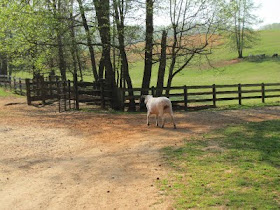Earlier this spring, I visited a sheep farm to watch the annual sheering. I had expected to see the sheering process, but had not anticipated that everywhere I looked there would be subject matter. It was close to overwhelming.
I saw potential paintings in every direction, hundreds of them. At first I was a bit stunned by the overload of images.
I saw potential paintings in every direction, hundreds of them. At first I was a bit stunned by the overload of images.
...a young girl riding her bike...
. ...lamas in the back pasture guarding the sheep...
... unsheered sheep in the holding areas...
...sheep being shifted in place for a sheering...
...and the sheering, itself.
This is another side of being a painter. It's a time NOT to compose, just to tune into whatever images get your adrenaline going and gather as many as you can. It's the flip side of having your subject in the studio with plenty of time to study it or of setting up to paint on location where the light moving is the only thing that makes you hustle.
What is done with the images gathered may or may not be significant. They could get filed into the archives of my computer or they could become the subject of a spate of work. That doesn't matter. What matters is that I not miss an opportunity to record something that spoke to me, even if I didn't understand at the moment what it was saying.
What is done with the images gathered may or may not be significant. They could get filed into the archives of my computer or they could become the subject of a spate of work. That doesn't matter. What matters is that I not miss an opportunity to record something that spoke to me, even if I didn't understand at the moment what it was saying.












